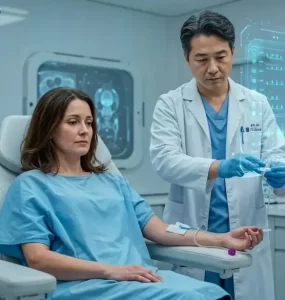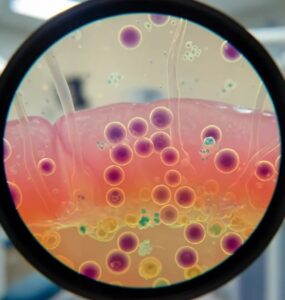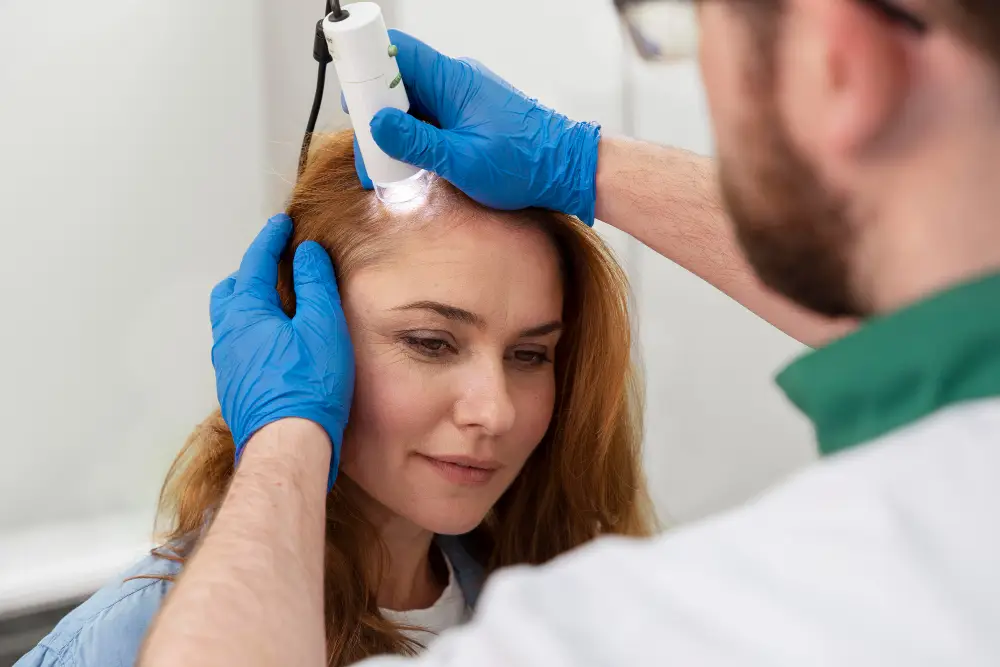
AMD Stem Cell Treatment: Pathways for Vision Clarity
Key Takeaways
- Age-related macular degeneration (AMD) significantly impacts central vision, driven by damage to the retina and retinal pigment epithelium (RPE).
- While conventional treatments manage symptoms, advanced research, including stem cell pathways, offers new avenues for understanding and potentially supporting vision.
- The team at Regencord in Pereira, Colombia, focuses on patient education and a transparent journey for those exploring responsible regenerative options.
- Pereira offers a compelling combination of advanced medical infrastructure, patient-centric support, and a serene environment for international medical care.
- Understanding your options and candidacy through a confidential case review is a strategic step toward informed decision-making.
Introduction: Navigating the Landscape of AMD
Receiving a diagnosis of age-related macular degeneration (AMD) can be a profoundly unsettling experience. The prospect of losing central vision, affecting daily activities from reading to recognizing faces, naturally brings forth a torrent of questions and concerns. For many, the search for answers extends beyond conventional treatments, leading to an exploration of advanced pathways, including the potential of AMD stem cell treatment.
At Regencord in Pereira, Colombia, our role is to provide clarity and support on this journey. We understand the emotional and practical complexities involved in exploring advanced medical options, especially when considering international care. This guide is designed to serve as a comprehensive educational resource, offering insights into AMD, the current landscape of regenerative medicine, and the unique advantages of pursuing care in Pereira, Colombia. Our aim is to empower you with the knowledge needed to make informed decisions about your vision health.
The Stakes & Critical Implications of Age-Related Macular Degeneration (AMD)

Age-related macular degeneration is a leading cause of vision loss among older adults globally. It progressively damages the macula, the central part of the retina responsible for sharp, detailed vision. Understanding the nature of AMD is the first step toward exploring effective management and potential advanced pathways.
Understanding AMD: Dry vs. Wet Forms
- Dry AMD: This is the more common form, accounting for 85-90% of cases. It develops slowly as light-sensitive cells in the macula gradually break down. The formation of drusen (yellow deposits) under the retina and thinning of the retinal pigment epithelium (RPE) are key characteristics. The RPE cells are crucial for supporting the photoreceptors, and their degeneration leads to progressive vision loss.
- Wet AMD: Less common but more aggressive, wet AMD occurs when abnormal blood vessels grow under the retina and leak fluid or blood, scarring the macula. This can cause rapid and severe vision loss.
According to the U.S. National Eye Institute (part of the U.S. National Institutes of Health – NIH), early detection and monitoring are vital for both forms. The World Health Organization (WHO) also highlights AMD as a significant contributor to vision impairment globally, underscoring the urgency for effective interventions.
The Impact on Quality of Life
The implications of AMD extend far beyond visual acuity. Patients often experience difficulties with:
- Reading and driving
- Recognizing faces
- Performing daily tasks that require fine detail
- Overall independence and mental well-being
The emotional toll of impending or progressive vision loss is profound, leading many to seek every possible avenue for support and intervention. This is where exploring advanced pathways, including those involving AMD stem cell treatment, becomes a crucial consideration for improving or maintaining vision clarity.
The Conventional Approach in the USA & Beyond

In countries like the USA, the standard of care for age-related macular degeneration primarily focuses on slowing progression and managing symptoms. These approaches, while important, often leave patients searching for more proactive or regenerative solutions, particularly for the dry form of AMD for which fewer direct interventions exist.
Current Treatments for AMD
- For Dry AMD: The Age-Related Eye Disease Study (AREDS) formula of vitamins and minerals is the primary intervention to slow progression in intermediate to advanced dry AMD. Unfortunately, there is no direct treatment to reverse vision loss once it occurs.
- For Wet AMD: Anti-VEGF (vascular endothelial growth factor) injections are the cornerstone of treatment. These medications help to stop the growth and leakage of abnormal blood vessels. While effective at preserving vision in many cases, they require ongoing injections and do not always result in significant vision restoration.
Regulatory bodies in the USA, such as the U.S. Food and Drug Administration (FDA), rigorously evaluate therapies, leading to a conservative approach to novel treatments, which are often confined to clinical trial settings for many years. Similarly, health authorities like Health Canada (for Canada) or the NHS (for the UK) follow strict guidelines based on established evidence.
The Search for Advanced Solutions
Given the limitations of conventional treatments, especially for dry AMD, the quest for advanced options like AMD stem cell treatment is entirely understandable. Patients are often left feeling that they need to proactively seek out emerging science and pathways that could offer hope for managing their condition beyond current standard protocols.
The Pereira, Colombia Advantage: A New Horizon for Care

For individuals exploring advanced options for age-related macular degeneration, considering care beyond their home country is a strategic decision. Pereira, Colombia, and specifically the team at Regencord, offers a compelling environment for those seeking high-standard, patient-centric care for advanced regenerative pathways.
Advanced Infrastructure & Medical Standards
Colombia has rapidly emerged as a recognized destination for medical tourism, underpinned by a robust and evolving healthcare infrastructure. The country’s Ministry of Health, in conjunction with regulatory bodies like INVIMA (National Food and Drug Surveillance Institute), ensures that medical facilities adhere to stringent national health standards. This oversight means that clinics like Regencord operate within a well-regulated framework, prioritizing patient safety and care quality.
Regencord, situated in Pereira, maintains modern facilities that integrate advanced diagnostic capabilities with spaces designed for comfort and recovery. Our team, composed of highly trained professionals, focuses on ensuring that every aspect of the patient journey meets international expectations for medical excellence.
A Holistic & Supportive Patient Journey
Navigating the landscape of advanced medical care, particularly for conditions like AMD, often introduces a profound sense of isolation for patients. Many feel overwhelmed by the sheer volume of conflicting information and the emotional toll of a progressive condition. Our experience has shown that providing a clear, empathetic, and guided pathway, focused not just on treatment but on holistic support, significantly reduces patient anxiety and empowers more confident decision-making.
Beyond the clinical advantages, the choice of a medical destination profoundly impacts the patient’s recovery journey. Pereira, with its serene natural environment, advanced medical infrastructure, and a culture of genuine hospitality, offers a unique therapeutic milieu. Patients often report that the supportive atmosphere, combined with streamlined logistical coordination, transforms a daunting medical journey into a manageable and even restorative experience, fostering well-being beyond the treatment itself.
Logistical Ease & Welcoming Environment
Pereira, often called “The Pearl of Otún,” is a vibrant city known for its beautiful landscapes and warm, welcoming culture. Its international airport (Matecaña International Airport) offers convenient access, simplifying travel for international patients. The city’s cost of living is also often more accessible compared to major medical hubs in the USA or Europe, contributing to a more manageable overall experience without compromising on the quality of care. The Regencord team assists with all aspects of logistics, including accommodation, local transportation, and interpreting services, ensuring a seamless experience.
Your Vision Clarity Pathway Guide: Empowering Your Journey

Understanding and navigating advanced pathways for age-related macular degeneration requires careful consideration and reliable information. To assist you in this crucial journey, the Regencord team has developed “The Vision Clarity Pathway Guide” – a practical resource designed to demystify the process and empower your decision-making.
This guide is not merely a checklist; it’s a structured approach to help you evaluate your options, prepare for discussions, and understand the steps involved in exploring advanced regenerative care for AMD. It focuses on the importance of assessing your candidacy, understanding the science, and preparing for the logistical aspects of care.
What “The Vision Clarity Pathway Guide” Covers:
- Understanding Your AMD Diagnosis: A comprehensive review of your specific condition (dry or wet AMD, stage, previous treatments) and current vision status. This section encourages collecting all relevant medical records for a thorough review.
- Exploring Regenerative Pathways: Insights into the scientific basis of certain regenerative approaches, including the role of the retinal pigment epithelium (RPE) in AMD and how stem cell research aims to support or replace damaged cells. It clarifies that these are pathways being explored, not universal cures.
- Candidacy Assessment Criteria: A detailed overview of the factors considered when evaluating if you might be a suitable candidate for specific advanced pathways. This includes medical history, overall health, and specific ophthalmological findings.
- The Regencord Patient Journey Map: A step-by-step breakdown of what to expect, from your initial confidential case review to arrival in Pereira, on-site consultations, and post-care coordination. This outlines the support structure provided by our patient advocacy team.
- Logistical Preparation Checklist: Practical considerations for international travel, including passport and visa requirements, accommodation options, and communication support, ensuring a smooth transition to and from Pereira.
- Questions to Ask: A curated list of essential questions for your medical team, empowering you to engage in informed discussions about potential benefits, considerations, and realistic expectations regarding AMD stem cell treatment and other regenerative approaches.
By utilizing “The Vision Clarity Pathway Guide,” you gain a structured framework for making one of the most important decisions regarding your vision health. It’s a testament to our commitment to education and patient empowerment.
Our Regenerative Philosophy & Approach at Regencord

At Regencord in Pereira, Colombia, our approach to advanced medical care, particularly for complex conditions like age-related macular degeneration, is rooted in a philosophy of responsible innovation, deep scientific understanding, and unwavering patient advocacy. We believe that empowering patients with knowledge and support is paramount, especially in the evolving field of regenerative medicine.
Science-Backed Exploration, Not Unverified Claims
The field of regenerative medicine, including AMD stem cell treatment, is dynamic and holds significant promise. Our focus is on pathways that are grounded in robust scientific research. We critically assess and consider approaches that have demonstrated potential in preclinical or clinical research, particularly those targeting key mechanisms of AMD progression, such as supporting or replacing the retinal pigment epithelium (RPE) or photoreceptor cells. We strictly adhere to an ethical framework, ensuring that all discussions and potential pathways presented are based on verifiable data from authoritative sources like the PubMed-indexed peer-reviewed journals and the ClinicalTrials.gov database for ongoing studies.
We do not make claims of “cure” or “guaranteed vision restoration.” Instead, we focus on exploring if a patient is a suitable candidate for specific, carefully considered regenerative approaches aimed at supporting visual function or slowing disease progression.
Patient-Centric Care: More Than Just a Treatment
Our philosophy extends beyond the clinical aspects. We recognize that patients exploring advanced treatments for conditions affecting vision clarity often face significant emotional and logistical challenges. Our team acts as a dedicated advocate, guiding you through every step of the process. This includes:
- Thorough Case Review: A meticulous evaluation of your medical history and diagnostic imaging to determine candidacy for specific pathways.
- Transparent Communication: Clear, honest discussions about the science, potential considerations, and what to realistically expect.
- Holistic Support: Assistance with travel arrangements, accommodation, language services, and local transportation, ensuring a comfortable and stress-free experience in Pereira.
- Post-Care Coordination: Support for follow-up care planning and communication with your local ophthalmologist.
This comprehensive, empathetic approach ensures that you feel supported, informed, and respected throughout your journey with us. Our goal is to provide a pathway toward informed action and potential improvement, always with the utmost ethical consideration.
Overcoming Common Hesitations: Why Seeking Clarity is a Strategic Advantage
Embarking on a journey to explore advanced medical treatments, especially in an international setting, naturally brings forth a set of common concerns. At Regencord, we believe that addressing these hesitations directly and transparently is fundamental to building trust and empowering your decision-making process for age-related macular degeneration.
“Is receiving medical care in Colombia safe or legitimate for AMD stem cell treatment?”
This is a vital question, and the answer lies in verifiable facts. Colombia boasts a robust healthcare infrastructure, with many institutions accredited by international bodies, and overseen by the Colombian Ministry of Health and INVIMA. These government entities ensure high standards of medical training, facility maintenance, and regulatory compliance. Our team operates within this well-regulated system, prioritizing patient safety and adherence to ethical guidelines. We invite you to shift your focus from generalized fears of the unknown to an understanding of a system that is both regulated and advancing, offering quality medical care.
“This sounds too complicated and overwhelming. I wouldn’t know where to start.”
We completely understand this feeling. The thought of coordinating international travel, medical appointments, and understanding new information can be daunting, especially when managing a condition like AMD. This is precisely why our dedicated patient advocacy team exists. We outline a clear, step-by-step patient journey for you. From your initial confidential case review to assisting with travel, accommodation, and on-site logistics in Pereira, we manage the complexities. This transforms a potentially overwhelming process into a manageable, supported pathway, allowing you to focus on your well-being and health, not on the logistics.
“I’m concerned about the cost. Will this be affordable, or will I be exploited?”
Financial considerations are a significant and valid concern. It’s important to understand that while quality medical care involves investment, the value proposition in Pereira, Colombia, can be compelling. We commit to transparency regarding all financial aspects during your confidential case review. Our focus is on providing access to high-quality care, advanced facilities, and personalized attention. We ensure you receive a clear breakdown of potential costs, allowing you to make an informed financial decision without any hidden surprises. We aim for clarity and value, not exploitation.
“What if these advanced regenerative pathways don’t work for my vision?”
This concern reflects a deep understanding of the challenges associated with advanced medical conditions. It’s important to reiterate that discussions around AMD stem cell treatment and other regenerative pathways are centered on *potential support* and *candidacy*, not guarantees of specific outcomes or vision restoration. We meticulously review each patient’s case to determine if they are a suitable candidate for particular pathways, based on current scientific understanding and the individual’s specific condition. Our approach is to provide a responsible avenue for exploring these options, ensuring that expectations are realistically managed and that all information is presented with integrity and an emphasis on ethical considerations. Seeking clarity, even if it leads to understanding limitations, is always a strategic advantage in managing your health.
Glossary of Key Terms
- Age-related Macular Degeneration (AMD): A common eye condition and a leading cause of vision loss among people 50 years and older. It causes damage to the macula, a small spot near the center of the retina, which is needed for sharp, central vision.
- Retina: The light-sensitive layer of tissue at the back of the eye that converts light into electrical signals, which are sent to the brain.
- Macula: The central part of the retina responsible for sharp, detailed central vision, essential for tasks like reading and recognizing faces.
- Retinal Pigment Epithelium (RPE): A layer of cells that nourish and support the light-sensitive photoreceptor cells of the retina. Degeneration of RPE cells is a key feature in AMD.
- Photoreceptors: Light-sensitive cells (rods and cones) in the retina that detect light and convert it into electrical signals.
- Stem Cells: Undifferentiated cells with the ability to develop into many different cell types in the body. They also have the capacity for self-renewal. In AMD research, various types of stem cells are being investigated for their potential to replace damaged RPE or photoreceptor cells.
- Regenerative Medicine: A broad field that aims to replace or “regenerate” human cells, tissues, or organs to restore or establish normal function.
- Clinical Trial: A research study conducted with human volunteers to evaluate the safety and efficacy of a medical, surgical, or behavioral intervention. Many AMD stem cell treatment pathways are currently in various stages of clinical trials.
- INVIMA: Colombia’s National Food and Drug Surveillance Institute, the primary regulatory body for health products and medical services in the country.
Frequently Asked Questions (FAQ)
What exactly is Age-related Macular Degeneration (AMD)?
AMD is a progressive eye condition affecting the macula, the central part of your retina, leading to blurry central vision or blind spots. It comes in two forms: dry AMD, which is more common and involves the thinning of the macula and the formation of drusen; and wet AMD, which involves abnormal blood vessel growth and leakage under the retina.
How do stem cells relate to AMD research?
Research into AMD stem cell treatment pathways focuses on the potential to replace or support damaged retinal cells, particularly the retinal pigment epithelium (RPE) cells that are crucial for nourishing photoreceptors. The goal is to potentially slow progression, prevent further damage, or even improve visual function, though most of these approaches are still investigational or under clinical study.
Are AMD stem cell treatments approved by regulatory bodies like the FDA?
As of now, most stem cell therapies for AMD are still in the investigational phase or limited to clinical trials globally, including in the USA and Europe. The U.S. FDA, for example, has approved very few stem cell products, none specifically for widespread AMD treatment outside of a research setting. Regencord’s approach is to provide access to carefully considered regenerative pathways within a regulated Colombian environment, always with transparency regarding their scientific basis.
What makes Pereira, Colombia, a suitable location for exploring these pathways?
Pereira offers a compelling combination of advanced medical facilities, highly trained professionals, and a supportive environment for international patients. Colombia’s healthcare system is well-regulated by entities like INVIMA, ensuring quality standards. The logistical support provided by the Regencord team, combined with the city’s welcoming culture and natural beauty, makes it a unique and accessible destination for exploring advanced medical care.
What does “confidential case review” involve?
A confidential case review involves a thorough evaluation of your medical history, diagnostic images, and current vision status by the Regencord team. This allows us to understand your specific condition, discuss the scientific basis of potential regenerative pathways, and determine if you might be a candidate for our programs. It’s an essential first step to ensure any potential pathway is appropriate for your individual needs.
Will I experience vision restoration?
It is important to manage expectations realistically. Discussions around advanced regenerative pathways for age-related macular degeneration focus on the potential to support visual function, slow disease progression, or prevent further deterioration. We cannot offer guarantees of “vision restoration.” Our objective is to provide a responsible avenue for exploring these options based on current scientific understanding and your specific candidacy.
How does Regencord ensure patient safety and ethical practice?
Our commitment to patient safety and ethical practice is paramount. We operate under the regulatory framework of Colombia’s Ministry of Health and INVIMA. All pathways considered are grounded in scientific literature from approved sources (e.g., NIH, PubMed-indexed journals). We prioritize transparent communication, informed consent, and rigorous patient selection to ensure that any potential pathway is suitable and ethically sound for each individual.



